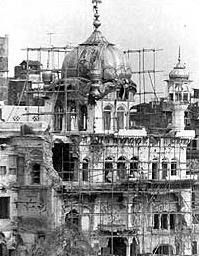
The Khalistan movement is a separatist movement seeking to create a homeland for Sikhs by establishing an ethno‐religious sovereign state called Khalistan in the Punjab region. The proposed boundaries of Khalistan vary between different groups; some suggest the entirety of the Sikh-majority Indian state of Punjab, while larger claims include Pakistani Punjab and other parts of North India such as Chandigarh, Haryana, and Himachal Pradesh. Shimla and Lahore have been proposed as the capital of Khalistan.

Operation Blue Star was an Indian Armed Forces operation between 1 and 10 June 1984 to remove Sikh militant Jarnail Singh Bhindranwale and other Sikh separatists from the buildings of the Golden Temple, the holiest site of Sikhism.

Jarnail Singh Bhindranwale was a Sikh militant. He was the leading figure of the Khalistan movement, although he did not personally advocate for a separate Sikh nation.

Giani Zail Singh was an Indian politician from Punjab who served as the seventh president of India from 1982 to 1987 and 9th Chief Minister of Punjab. He was the first Sikh to become president.

Babbar Khalsa International, better known as Babbar Khalsa, is a Sikh militant organisation that aims to create an independent Sikh nation of Khalistan in the Indian state of Punjab. It has used armed attacks, assassinations and bombings in aid of that goal, and is deemed to be a terrorist entity by various governments. Besides India, it operates in North America and Europe, including Scandinavia.

The Insurgency in Punjab, India was an armed campaign by the militants of the Khalistan Movement from the mid-1980s to the mid-1990s. Economic and social pressures driven by the Green Revolution prompted calls for Sikh autonomy and separatism. This movement was initially peaceful, but foreign involvement and political pressures drove a heavy handed response from Indian authorities. The demand for a separate Sikh state gained momentum after the Indian Army's Operation Blue Star in 1984 aimed to flush out militants residing in the Golden Temple in Amritsar, a holy site for Sikhs. Terrorism, police brutality and corruption of the authorities greatly exacerbated a tense situation. By the mid-1980s, the movement had evolved into a militant secessionist crisis due to the perceived indifference of the Indian state in regards to mutual negotiations. Eventually, more effective police and military operations, combined with a policy of rapprochement by the Indian government and the election loss of separatist sympathizers in the 1992 Punjab Legislative Assembly election, largely quelled the rebellion by the mid-1990s.

Kehar Singh was an Assistant in the erstwhile Directorate General of Supply and Disposal, New Delhi, and was tried and executed for conspiracy in the plot of the Indira Gandhi assassination, carried out by Satwant Singh and Beant Singh. He was hanged in Tihar Jail on 6 January 1989. Beant Singh was the nephew of Kehar Singh. The assassination was "motivated" by Operation Blue Star.

Amrik Singh was the President of the All India Sikh Students Federation. He was killed in the Indian Army's operation on the Golden Temple on June 6, 1984.

Harjinder Singh Jinda was a Sikh militant and one of the two assassins of Arun Vaidya. He was responsible for three high-profile assassinations: Arjan Dass, Lalit Maken and Gen. Vaidya. He along with other members of Khalistan Commando Force participated in Indian history's biggest bank robbery of ₹ 57 million from Punjab National Bank, Miller Gunj branch, Ludhiana to finance the militancy for a separate Sikh state of Khalistan.
Operation Black Thunder is the name given to two operations that took place in India in the late 1980s to flush out remaining pro-Khalistan Sikh militants from the Golden Temple using 'Black Cat' commandos of the National Security Guards and commandos from Border Security Force. Like Operation Blue Star, these attacks were on the Sikh militants based in the Golden Temple in Amritsar, Punjab.

Sant Harchand Singh Longowal was the President of the Akali Dal during the Punjab insurgency of the 1980s. He had signed the Punjab accord, also known as the Rajiv-Longowal Accord along with Rajiv Gandhi on 24 July 1985. The government accepted most of the demands of Akali Dal who in turn agreed to withdraw their agitation. Less than a month after signing the Punjab accord, Sant Longowal was assassinated by Gyan Singh Leel and Jarnail Singh Halvara.

The Dashmesh Regiment was a militant group, and is part of the Khalistan movement to create a Sikh homeland called Khalistan via armed struggle.

Sukhdev Singh Dhillon, best known as General Labh Singh and also known as Sukha Sipahi and just Labh Singh, was a former Punjab police officer turned militant who took command of the Khalistan Commando Force after its first leader, Manbir Singh Chaheru, was arrested in 1986.

Bhai Manbir Singh Chaheru Also known as General Hari Singh was the founder and first leader of the militant organisation Khalistan Commando Force.
The Dharam Yudh Morcha was a religious political movement in Punjab, India launched on 4 August 1982, by the Akali Dal in partnership with Jarnail Singh Bhindranwale, with its stated aim being the fulfillment of a set of devolutionary objectives based on the Anandpur Sahib Resolution.

Operation Sundown was codename of a covert plan of India's external intelligence agency Research & Analysis Wing (R&AW), in which the Special Group, which is an ultra-secretive armed unit of the R&AW, was to abduct Sikh extremist leader Jarnail Singh Bhindranwale from Guru Nanak Niwas in the Golden Temple complex, Amritsar.

The 1978 Sikh–Nirankari clash occurred between the Sant Nirankari Mission and Sikhs of Damdami Taksal and Akal Kirtani Jatha on 13 April 1978 at Amritsar, Punjab, India. Sixteen people—thirteen traditional Sikhs and three Nirankari followers—were killed in the ensuing violence, occurring when some Akhand Kirtani Jatha and Damdami Taksal members led by Fauja Singh protested against and tried to stop a convention of Sant Nirankari Mission followers. This incident is considered to be a starting point in the events leading to Operation Blue Star and the 1980s insurgency in Punjab.
The 1983 Dhilwan Bus massacre was a massacre of 6 Hindus by Sikh extremists amidst the Insurgency in Punjab. It occurred on 5 October 1983, when a bus going from Dhilwan in Kapurthala district to Jalandhar was attacked by Sikh militants in which six Hindu passengers were shot dead in Dhilwan in the northern state of Punjab, India.
The Rasta Roko Morcha was an agitation launched in India by the Akali Dal in April of 1983 under Harchand Singh Longowal as part of Dharam Yudh Morcha.

Surinder Singh Sodhi was a Sikh militant known for being the chief bodyguard, chief hitman, transport minister, and right-hand man of Jarnail Singh Bhindranwale.















